Daniel Buschek
Composable Prompting Workspaces for Creative Writing: Exploration and Iteration Using Dynamic Widgets
Mar 27, 2025



Abstract:Generative AI models offer many possibilities for text creation and transformation. Current graphical user interfaces (GUIs) for prompting them lack support for iterative exploration, as they do not represent prompts as actionable interface objects. We propose the concept of a composable prompting canvas for text exploration and iteration using dynamic widgets. Users generate widgets through system suggestions, prompting, or manually to capture task-relevant facets that affect the generated text. In a comparative study with a baseline (conversational UI), 18 participants worked on two writing tasks, creating diverse prompting environments with custom widgets and spatial layouts. They reported having more control over the generated text and preferred our system over the baseline. Our design significantly outperformed the baseline on the Creativity Support Index, and participants felt the results were worth the effort. This work highlights the need for GUIs that support user-driven customization and (re-)structuring to increase both the flexibility and efficiency of prompting.
CorpusStudio: Surfacing Emergent Patterns in a Corpus of Prior Work while Writing
Mar 16, 2025Abstract:Many communities, including the scientific community, develop implicit writing norms. Understanding them is crucial for effective communication with that community. Writers gradually develop an implicit understanding of norms by reading papers and receiving feedback on their writing. However, it is difficult to both externalize this knowledge and apply it to one's own writing. We propose two new writing support concepts that reify document and sentence-level patterns in a given text corpus: (1) an ordered distribution over section titles and (2) given the user's draft and cursor location, many retrieved contextually relevant sentences. Recurring words in the latter are algorithmically highlighted to help users see any emergent norms. Study results (N=16) show that participants revised the structure and content using these concepts, gaining confidence in aligning with or breaking norms after reviewing many examples. These results demonstrate the value of reifying distributions over other authors' writing choices during the writing process.
Exploring Mobile Touch Interaction with Large Language Models
Feb 11, 2025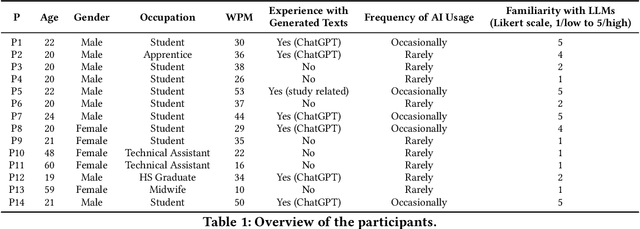

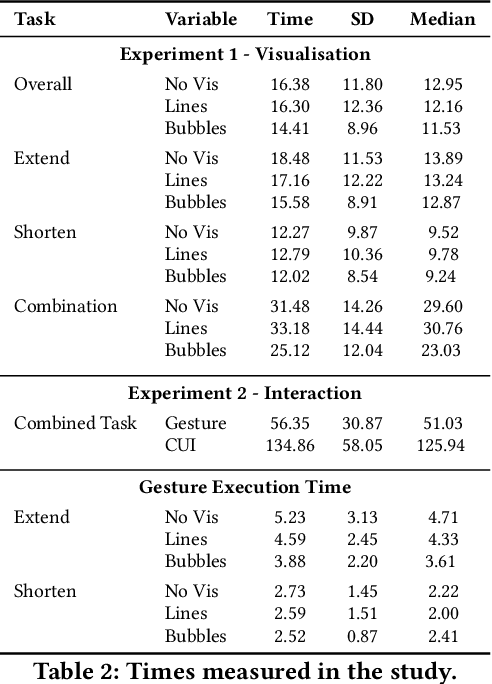
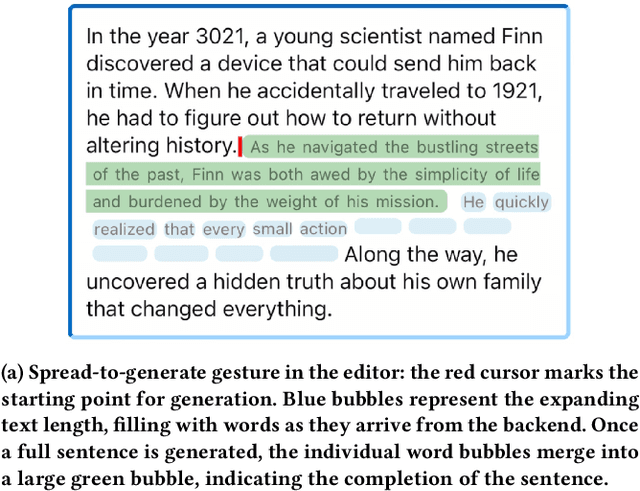
Abstract:Interacting with Large Language Models (LLMs) for text editing on mobile devices currently requires users to break out of their writing environment and switch to a conversational AI interface. In this paper, we propose to control the LLM via touch gestures performed directly on the text. We first chart a design space that covers fundamental touch input and text transformations. In this space, we then concretely explore two control mappings: spread-to-generate and pinch-to-shorten, with visual feedback loops. We evaluate this concept in a user study (N=14) that compares three feedback designs: no visualisation, text length indicator, and length + word indicator. The results demonstrate that touch-based control of LLMs is both feasible and user-friendly, with the length + word indicator proving most effective for managing text generation. This work lays the foundation for further research into gesture-based interaction with LLMs on touch devices.
Content-Driven Local Response: Supporting Sentence-Level and Message-Level Mobile Email Replies With and Without AI
Feb 10, 2025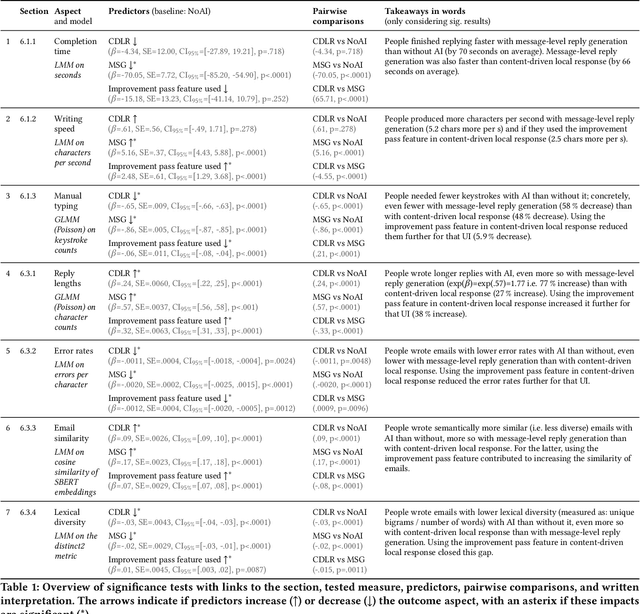
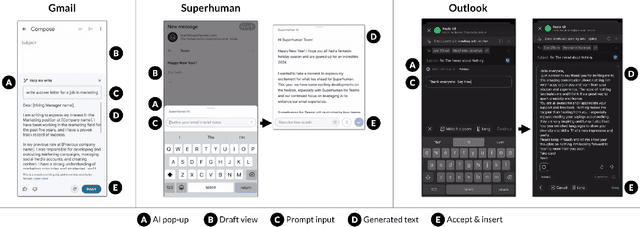
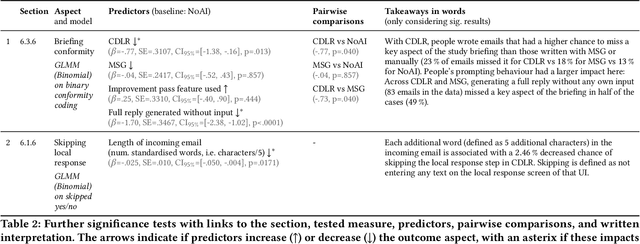
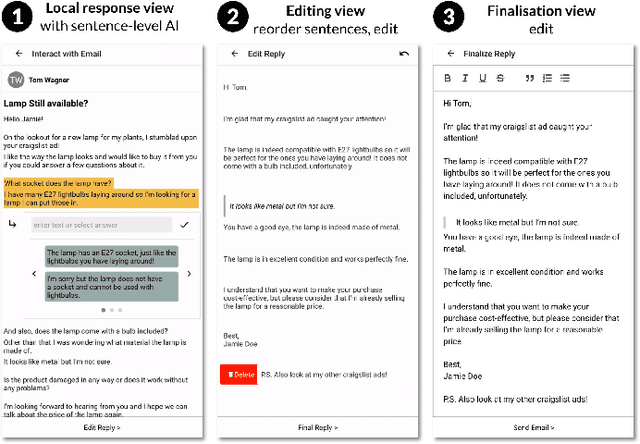
Abstract:Mobile emailing demands efficiency in diverse situations, which motivates the use of AI. However, generated text does not always reflect how people want to respond. This challenges users with AI involvement tradeoffs not yet considered in email UIs. We address this with a new UI concept called Content-Driven Local Response (CDLR), inspired by microtasking. This allows users to insert responses into the email by selecting sentences, which additionally serves to guide AI suggestions. The concept supports combining AI for local suggestions and message-level improvements. Our user study (N=126) compared CDLR with manual typing and full reply generation. We found that CDLR supports flexible workflows with varying degrees of AI involvement, while retaining the benefits of reduced typing and errors. This work contributes a new approach to integrating AI capabilities: By redesigning the UI for workflows with and without AI, we can empower users to dynamically adjust AI involvement.
Assisted Data Annotation for Business Process Information Extraction from Textual Documents
Oct 02, 2024



Abstract:Machine-learning based generation of process models from natural language text process descriptions provides a solution for the time-intensive and expensive process discovery phase. Many organizations have to carry out this phase, before they can utilize business process management and its benefits. Yet, research towards this is severely restrained by an apparent lack of large and high-quality datasets. This lack of data can be attributed to, among other things, an absence of proper tool assistance for dataset creation, resulting in high workloads and inferior data quality. We explore two assistance features to support dataset creation, a recommendation system for identifying process information in the text and visualization of the current state of already identified process information as a graphical business process model. A controlled user study with 31 participants shows that assisting dataset creators with recommendations lowers all aspects of workload, up to $-51.0\%$, and significantly improves annotation quality, up to $+38.9\%$. We make all data and code available to encourage further research on additional novel assistance strategies.
Collage is the New Writing: Exploring the Fragmentation of Text and User Interfaces in AI Tools
May 27, 2024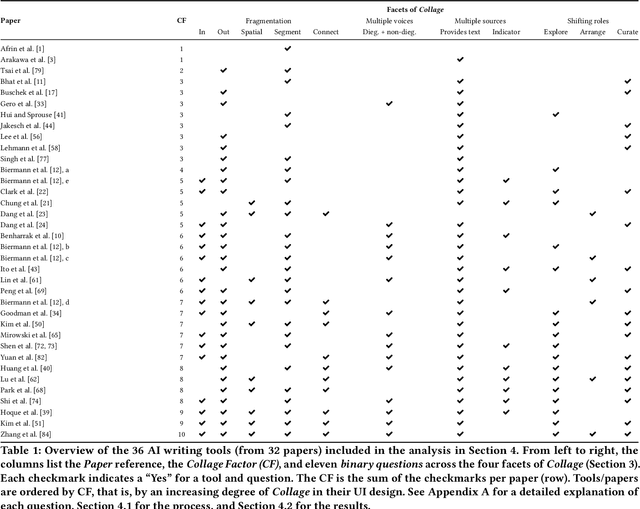
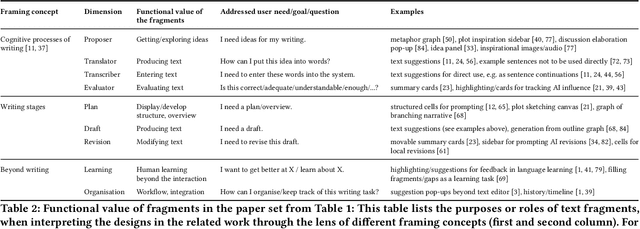
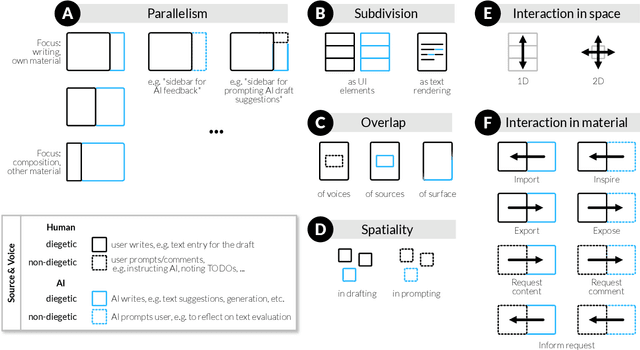
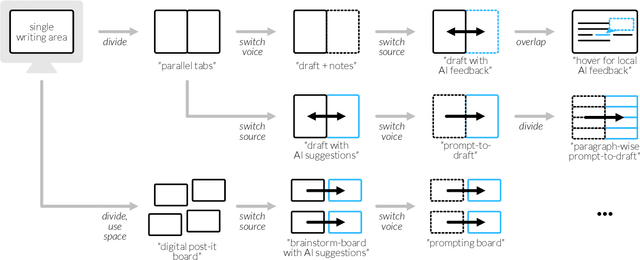
Abstract:This essay proposes and explores the concept of Collage for the design of AI writing tools, transferred from avant-garde literature with four facets: 1) fragmenting text in writing interfaces, 2) juxtaposing voices (content vs command), 3) integrating material from multiple sources (e.g. text suggestions), and 4) shifting from manual writing to editorial and compositional decision-making, such as selecting and arranging snippets. The essay then employs Collage as an analytical lens to analyse the user interface design of recent AI writing tools, and as a constructive lens to inspire new design directions. Finally, a critical perspective relates the concerns that writers historically expressed through literary collage to AI writing tools. In a broad view, this essay explores how literary concepts can help advance design theory around AI writing tools. It encourages creators of future writing tools to engage not only with new technological possibilities, but also with past writing innovations.
Deceptive Patterns of Intelligent and Interactive Writing Assistants
Apr 14, 2024Abstract:Large Language Models have become an integral part of new intelligent and interactive writing assistants. Many are offered commercially with a chatbot-like UI, such as ChatGPT, and provide little information about their inner workings. This makes this new type of widespread system a potential target for deceptive design patterns. For example, such assistants might exploit hidden costs by providing guidance up until a certain point before asking for a fee to see the rest. As another example, they might sneak unwanted content/edits into longer generated or revised text pieces (e.g. to influence the expressed opinion). With these and other examples, we conceptually transfer several deceptive patterns from the literature to the new context of AI writing assistants. Our goal is to raise awareness and encourage future research into how the UI and interaction design of such systems can impact people and their writing.
A Design Space for Intelligent and Interactive Writing Assistants
Mar 26, 2024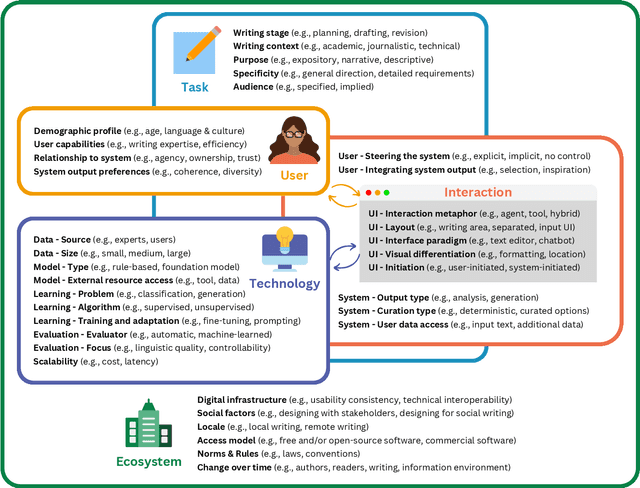
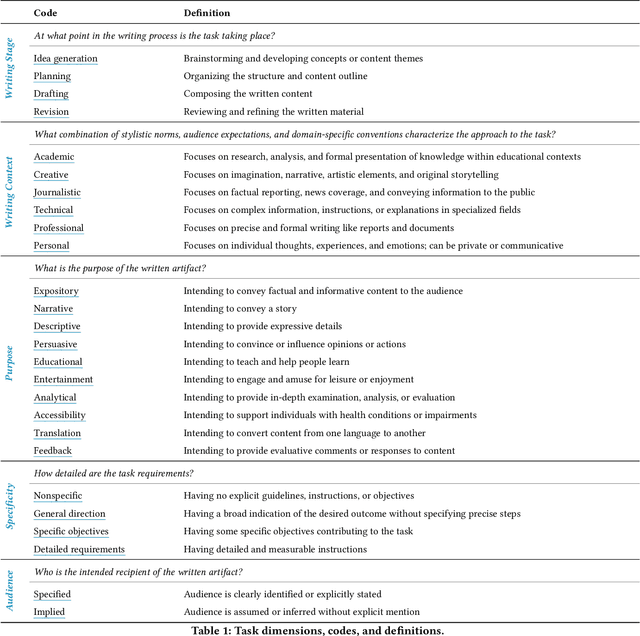
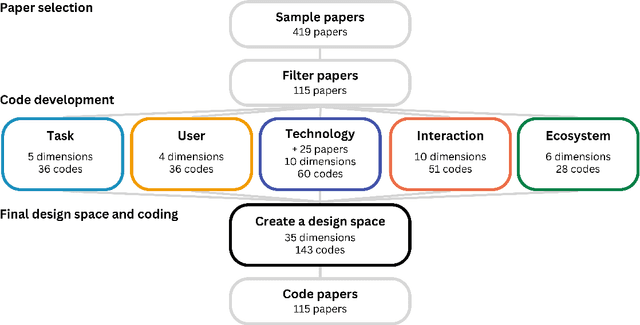
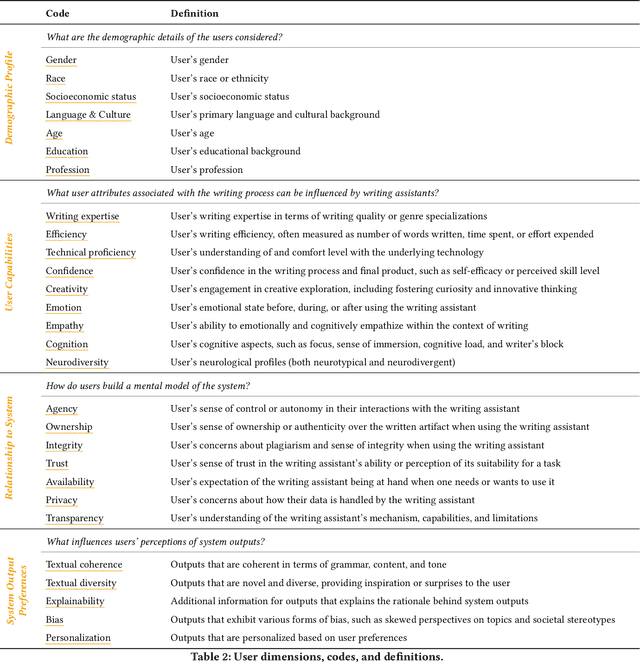
Abstract:In our era of rapid technological advancement, the research landscape for writing assistants has become increasingly fragmented across various research communities. We seek to address this challenge by proposing a design space as a structured way to examine and explore the multidimensional space of intelligent and interactive writing assistants. Through a large community collaboration, we explore five aspects of writing assistants: task, user, technology, interaction, and ecosystem. Within each aspect, we define dimensions (i.e., fundamental components of an aspect) and codes (i.e., potential options for each dimension) by systematically reviewing 115 papers. Our design space aims to offer researchers and designers a practical tool to navigate, comprehend, and compare the various possibilities of writing assistants, and aid in the envisioning and design of new writing assistants.
Writer-Defined AI Personas for On-Demand Feedback Generation
Sep 19, 2023
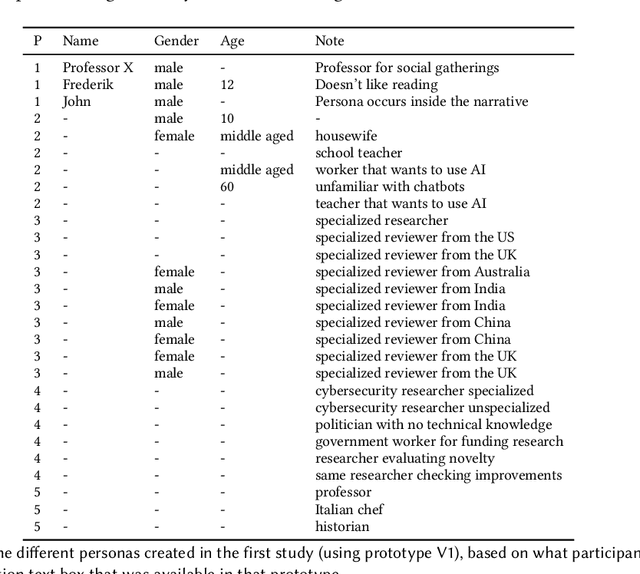
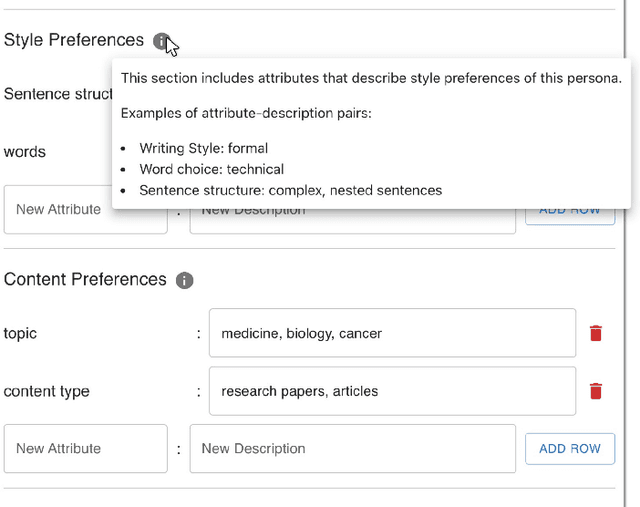
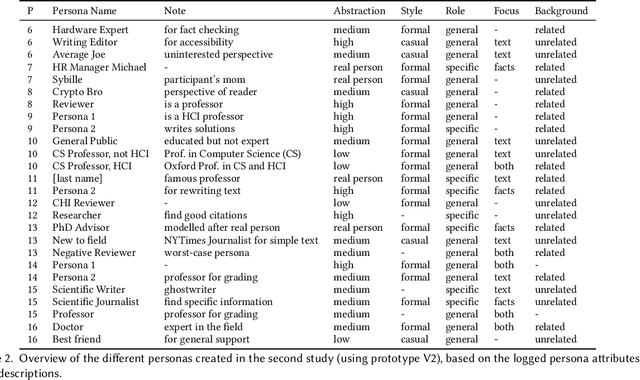
Abstract:Compelling writing is tailored to its audience. This is challenging, as writers may struggle to empathize with readers, get feedback in time, or gain access to the target group. We propose a concept that generates on-demand feedback, based on writer-defined AI personas of any target audience. We explore this concept with a prototype (using GPT-3.5) in two user studies (N=5 and N=11): Writers appreciated the concept and strategically used personas for getting different perspectives. The feedback was seen as helpful and inspired revisions of text and personas, although it was often verbose and unspecific. We discuss the impact of on-demand feedback, the limited representativity of contemporary AI systems, and further ideas for defining AI personas. This work contributes to the vision of supporting writers with AI by expanding the socio-technical perspective in AI tool design: To empower creators, we also need to keep in mind their relationship to an audience.
Choice Over Control: How Users Write with Large Language Models using Diegetic and Non-Diegetic Prompting
Mar 06, 2023



Abstract:We propose a conceptual perspective on prompts for Large Language Models (LLMs) that distinguishes between (1) diegetic prompts (part of the narrative, e.g. "Once upon a time, I saw a fox..."), and (2) non-diegetic prompts (external, e.g. "Write about the adventures of the fox."). With this lens, we study how 129 crowd workers on Prolific write short texts with different user interfaces (1 vs 3 suggestions, with/out non-diegetic prompts; implemented with GPT-3): When the interface offered multiple suggestions and provided an option for non-diegetic prompting, participants preferred choosing from multiple suggestions over controlling them via non-diegetic prompts. When participants provided non-diegetic prompts it was to ask for inspiration, topics or facts. Single suggestions in particular were guided both with diegetic and non-diegetic information. This work informs human-AI interaction with generative models by revealing that (1) writing non-diegetic prompts requires effort, (2) people combine diegetic and non-diegetic prompting, and (3) they use their draft (i.e. diegetic information) and suggestion timing to strategically guide LLMs.
 Add to Chrome
Add to Chrome Add to Firefox
Add to Firefox Add to Edge
Add to Edge